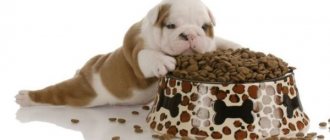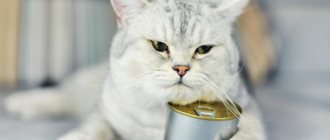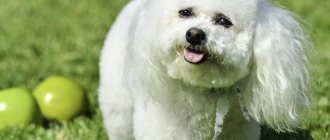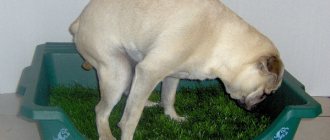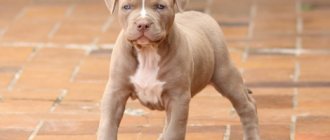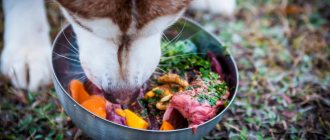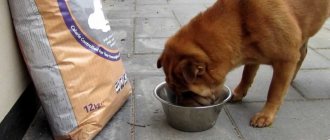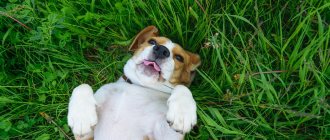04/21/2019 Drozd Nikolaevich Animals
Pet dog owners often wonder how to help their pet gain weight. Severe thinness may be the result of a serious illness or other reasons. How to fatten a dog? This process is slow and requires compliance with certain rules.
Which dogs need to be fattened?
Female dogs can become emaciated after nursing a large litter of more than a dozen puppies. Also, emaciated animals after a serious illness or surgery need special nutrition.
Street dogs or pets that are lost and have been without a home for a long time can become exhausted. If stray animals are accustomed to feeding on leftover food from garbage dumps, then lost pets may refuse such food and lose a lot of weight.
Another cause of exhaustion is infection with parasites. Therefore, before you start fattening your dog, you should contact a veterinarian and rid the animal of worms.
Wasting is also possible in dogs that have to work hard but don't have enough calories to eat. This is especially possible for four-legged animals that transport cargo over long distances.
Sometimes it is necessary for the dog to gain weight before participating in the exhibition. It happens that it is necessary to show some characteristics of the breed, so dogs are forced to gain weight or lose weight.
An animal in old age may refuse food due to poor health. They are more susceptible to exhaustion than other pets due to metabolic disorders. How to fatten a dog in this case? You will definitely need the help of a veterinarian who will help you adjust the animal’s diet.
Causes of weight loss
Sometimes the owner of a four-legged creature notices that his pet suddenly began to rapidly lose weight and eat poorly. The best way out of the situation is to show the dog to a veterinarian and undergo a comprehensive comprehensive examination. However, keep in mind the fact that this will cost you a decent amount. That’s why you should first establish the reason for your dog’s rapid weight loss, and only then make a decision.
Common factors that cause weight loss in a pet include the following:
- Feeding your pet's offspring. After this, the dog usually requires serious recovery.
- Dogs living in the same house cannot share food among themselves. In this case, it is advisable to isolate the malnourished dog from other individuals during feeding.
- The dog suffered from a helminth infestation. In this case, you need to give the animal special anti-worm medications, otherwise the consequences may be tragic.
- This is due to the young age and individual characteristics of the breed.
Feeding offspring
Lack of appetite is not always associated with health problems in your pet. Sometimes she does not feed very actively and at the same time loses weight due to the fact that most of the nutritional components are lost along with the milk. When a dog fattens its offspring, it often loses weight. In this case, it is recommended to increase the portions.
Also make sure that your daily menu includes vitamins. Then the puppies will receive more useful substances along with their mother’s milk, and the tailed mother herself will not actively lose weight. We should not forget that sometimes the birth of babies in dogs is associated with serious complications. The reason for this is surgery or illness.
High competition for food
Sometimes the owner of four-legged creatures does not notice the exhaustion of one of the pets in a timely manner. It would seem that the food is distributed evenly, and each of your doggies has their own bowl for food. However, keep an eye on your animals while feeding: it is quite possible that someone is left without treats because they cannot win their “place in the sun.” All you have to do is feed the deprived dog in another room so that his food is not taken away.
The influence of diseases and parasites
Another way to increase a dog’s appetite if it is noticeably exhausted is to eliminate parasites. The animal is often predisposed to pest infestations. That is why anthelmintic drugs are recommended to be given as prophylactic agents. If this is not done in advance, the number of helminths in the dog’s body increases, which leads to its excessive exhaustion. It is necessary to provide treatment and improve the dog’s appetite, otherwise the consequences will affect not only the pet’s weight, but will also become a threat to his life.
Age and characteristics of the breed
Among the reasons for a dog's sudden weight loss, it is also worth highlighting its age and individual characteristics. For example, representatives of working dog breeds often gain weight by the age of 2–3 years. This is explained by the fact that the animal’s metabolism is too active at an early age. Therefore, it is not worth increasing the daily diet.
Keep an eye on your dog first: if he continues to lose weight, you should show him to a specialist and check if everything is in order with his health. After consultation with your veterinarian, you can modify your daily diet.
Diet for fattening
How to fatten a dog? It’s easier to do this on a natural basis. This food has a distinct taste and smell that dogs like. Industrially produced food is not so appetizing, many animals quickly get tired of it. The exception is canned dog food - they can be called more of a delicacy.
If your pet is used to eating dry food, it can be varied. For example, mix with grated cheese, chopped boiled meat, egg, cottage cheese.
It is important for young dogs, as well as pregnant and lactating females, to eat fermented milk products: kefir, fermented baked milk, cottage cheese, cheese, yogurt. This will help digestion and improve stool.
What else can you offer your pet?
It is useful to give dogs boiled fish every week, after removing the bones. Only low-fat varieties are suitable for pets.
Eggs contain many vitamins and healthy cholesterol. They are given to four-legged animals boiled.
Plant foods (cereals, fruits, vegetables) provide the body with the necessary carbohydrates and stimulate the digestive system.
In addition to a properly selected diet for an exhausted dog, it is also important to increase the number of meals. Pets are fed three to eight times a day.
If the animal refuses food, warm water is poured into it from a syringe without a needle and a glucose solution is injected.
Is it acceptable to feed a dog cat food?
Pet food manufacturers differentiate between dog and cat food for a reason. These pets have different needs and all this is taken into account in the qualitative and quantitative composition of their food. Therefore, it is wrong to feed a dog with cat food, as well as a cat with dog food.
For example, cat food contains more proteins. And a dog, if it regularly eats such food, has every chance of quickly getting a metabolic disorder. And also serious problems with the digestive tract, kidney failure and skin rashes.
In addition, cats have a need for the amino acid taurine, which is reflected in the composition of cat food. Dogs are capable of generating this amino acid on their own, and an additional dose of taurine from the outside is detrimental to canine health.
And in general, dogs and cats need different ratios of proteins, fats and carbohydrates and different amounts of vitamins and amino acids. Therefore, systematically feeding a dog with cat food is unacceptable.
It’s another matter if the dog ate cat food just once – this is not a reason to panic. The difficulty can be observed if you have both a cat and a dog living at home at the same time. For some reason, animals often think that the food in their neighbor’s bowl tastes better. In addition, dogs can use their physical superiority and take food from cats. The solution is to feed each pet individually so that no one is tempted to eat their neighbor’s food.
How to fatten a dog?
Meat becomes the main component of the menu for skinny animals. It is a source of essential amino acids that are not found in plant foods and fish. If a dog has not eaten meat for a long time, it is given boiled meat and only lean meat. The daily menu consists of 75-80% meat.
The rest of the diet is plant foods. For example, cereals. Dogs can be given buckwheat, oats, rice. Corn can cause allergies. Wheat is not suitable for feeding carnivores. When cooking cereals, no salt is added. Meat cut into pieces, as well as vegetables, fruits, and herbs are added to the porridge.
If a dog has suffered enteritis, its food should be pureed and semi-liquid: boiled pieces of meat, fermented milk products, liquid oatmeal, vegetable soup.
The female's nutrition after weaning the puppies is supposed to be enhanced, according to a certain feeding scheme for pregnant and lactating dogs.
Preparation for competitions
If the dog needs to gain weight before the show, reduce its physical activity and increase the daily portion of food. The diet does not change. If a dog is ready for a show, it means that it is in great shape and its menu is completely suitable for it. In addition, the introduction of new products can negatively affect the health and mood of the animal. Shedding may begin, discharge from the nose and eyes, and redness of the ears. Of course, such manifestations will only reduce the pet’s performance at the show.
Growth stimulants for the German Shepherd
Hello, I have a German Shepherd, a 7 month old girl. She is like a dwarf - she looks like a four-month-old puppy. At the withers 45 cm, weight 10 kg. He doesn't eat well and started going to training. A dog handler with enormous experience throws up his hands and says, this is the first time he’s seen something like this! Maybe give her growth stimulants? Please tell me!
Answer 1
The German Shepherd is a large breed dog; an adult female can weigh up to 35 kilograms in weight and 63 centimeters in height. Full growth of large breeds occurs more slowly than that of small breeds, and the animal continues to grow until 2-3 years of age.
Impact on dog development
The following factors influence the full development of your pet:
- Balanced, proper nutrition. It is a misconception that a dog should eat a lot, in large portions - it should eat in such a way as to receive the necessary microelements.
- Training – absence or presence affects the mental and physical components.
- The quality of the pet's living conditions.
- Heredity, predisposition to diseases.
Stages of dog development
Puppies grow up in several stages:
- Being in the womb. There is an appropriation of the basic qualities of the future dog from its parents.
- Breastfeeding (0-1.5 months). The main responsibility during this period lies with the breeder, organizing housing conditions for the mother and offspring, and the availability of adequate nutrition for the mother.
- Intensive growth of the puppy (1.5-6 months).
- Depending on the breed, active growth continues or slows down (6-16 months).
- Formation of an adult animal, gain of muscle mass (2-2.5 years).
Non-compliance with height and weight standards
The German Shepherd is finally formed only by the age of three, but you need to understand the norms of the dog’s parameters during the age periods. By the age of one year, a healthy shepherd weighs about 30 kilograms. If deviations are present, you should contact a veterinarian for help.
Underweight can be associated with non-compliance with conditions that promote the growth of a pet - monotonous nutrition, lack of physical activity, parental heredity. Breeders may be unscrupulous and sell dogs that are not purebred - perhaps the current complexion is natural for a mestizo. A known genetic deviation is the dwarf shepherd. The disease is inherited; only doctors can help determine it.
Dwarf Shepherd
It is not a breed type and is not bred separately, as it develops due to a genetic abnormality. Individuals are sterilized, preventing them from having offspring. A dwarf dog appears from healthy parents; it is impossible to predict in advance the birth of such a puppy.
Until a certain age, they are no different from their brothers. The phenomenon is not considered a cute quirk, but is a serious disruption to the functioning of the body. Without proper care, dogs with this disease can live no more than 5 years; they require special care and medical supervision. At the first symptoms of “dwarfism,” the animal is prescribed a course of growth hormones to help it fully develop.
Use of pharmacology
It is common to think that excess feed will help grow, but this can cause diseases and disorders, rather than accelerate development. For growth, the hormone somatotropin is often used, which increases blood levels. Exposure can provoke uneven growth of organs and the animal’s body, which will lead to disruption of body functions and imbalances. A method is used to find the balance of vitamin D deficiency and the ratio of phosphorus and calcium, as a result the development of the pet is accelerated. This method is dangerous by creating an artificial deficiency, which leads to disproportionate development or insufficient strengthening of the bone corset.
The use of tablets (injections) requires examination by a veterinarian. The deviation could be caused by a hidden illness, genetics, malnutrition, or lack of physical activity. Intervention of additional methods to speed up the process without indications can make a dog disabled. Contact the hospital for tests; the shepherd's decreased appetite may indicate the presence of pathologies that interfere with normal development.
What not to do?
Some time ago, dog breeders advised adding semolina to the diet of a skinny animal. However, today experts do not recommend doing this. Dogs do not respond well to wheat and products made from it, and semolina is the result of processing this grain. Dogs are often allergic to semolina.
Also, you should not give your pets fatty meats - pork and lamb. This is harmful to the liver and pancreas, and puts a strain on the gallbladder. In addition, pork often causes allergies.
Ideal types of meat for dogs are rabbit, turkey, veal, and horse meat. They are boiled, cut into pieces, plant ingredients are added and fed to pets.
During the fattening period, you should not replace meat with offal. They are not as nutritious and are less digestible. The only exception is the liver. It can be given instead of meat, after boiling it.
To fatten a dog, you need to increase the calorie content of its diet. In this case, first of all, carbohydrate-containing food comes to the rescue, so the animal is cooked porridge in broth and vegetables are added to it.
Is it worth purchasing ready-made food?
If the owner chooses ready-made wet food for fattening, it is advisable to purchase premium or super-premium products. Along with them, economy class positions are also produced. In any case, wet food is an excellent nutrition option for malnourished animals.
The advantages of the product are that:
- the feed has a balanced composition;
- natural and healthy ingredients included;
- Products are produced in various categories, including prices.
Nutritional supplements
How and what else to feed an emaciated dog to help it gain weight? Among the useful additives:
- Meat and bone meal is a powder obtained from processed animal carcasses. In some countries it is used as fertilizer. In dog nutrition it is considered a source of calcium, phosphorus, and protein. Large pets are given up to 2 teaspoons of flour per day, adding to food before serving.
- Fish oil is a useful supplement that strengthens the animal’s immune system and skeletal system. The product helps prevent many diseases. Give fish oil to the dog 2-3 times a week, mixing a small amount of it into food in the dosage prescribed on the product’s packaging.
- Seaweed is a source of iodine and other beneficial microelements. Large dogs can be given up to 100-150 grams per day.
- Plantain - normalizes the functioning of the gastrointestinal system, improves the blood formula, and raises hemoglobin levels. You can add a little of the leaves of this herb to your dog's food.
- Eleutherococcus leaves - increase the dog’s performance, normalize heart function, are used as a growth stimulant, and improve coat quality. It is used in the form of a pharmaceutical tincture, which is given to dogs half an hour before meals. For small animals, 7 drops are enough, for large animals - 30.
How to help your dog gain weight?
Contents hide
How to help your dog gain weight?
In our article today we will talk about dogs, which people aptly call “skin and bones”. No matter how hard the owner tries, no matter what he does, the pet still looks, to put it mildly, skinny. We will try to understand the problem with the help of professional experts. Perhaps the owner, without knowing it, purchases low-quality, low-calorie food. It is possible that the animal simply does not consume the daily supply of calories necessary to maintain health, in accordance with its activity level and lifestyle.
First, go to the vet. Double-check the food packages you give your pet. Check whether it is a dietary product or intended for dogs suffering from chronic diseases. Try to calculate the optimal amount of calories your pet needs to stay healthy. Maybe you really are underfeeding the animal? If the audit does not reveal any abnormalities, the food is sufficient, then it is better to contact a veterinarian. The specialist will prescribe tests that will determine whether your pet suffers from diabetes, thyrotoxicosis, cancer, diseases of the digestive system, etc. Is the dog healthy? Great, but her diet should be completely revised under the supervision of a doctor.
How will we change our diet? Pay close attention to how your dog eats. Does she eat her usual food with pleasure or is she “cranky”? And with all this, do you vouch for the quality of the food? It is possible that the animal simply “does not like” the food of a particular brand. I didn't like it, that's all! Try something similar. Go ahead. Are you too carried away with dry kibble food? Try introducing more wet or canned food into your diet. However, be careful when adjusting the diet - accustom your dog to new food carefully and carefully to avoid gastrointestinal disorders. It is advisable to discuss any significant changes in diet with your veterinarian.
Some useful tips. It’s rare, but you come across dogs that are very picky about food. For example, they will not eat canned food that has just been taken out of the refrigerator. Try serving them slightly warm, just heat them in the microwave (no more than 20 seconds). Now make sure the food is neither hot nor cold – medium. Add non-concentrated chicken or beef broth to dry food - your dog should like it. Try giving special bagged food in jelly or sauce.
It’s a good idea to increase the carbohydrate component as well. Boil pasta or rice several times a week and give a few tablespoons along with your regular food. In consultation with your veterinarian, you can increase the amount of fat in the diet. Finally, if your dog is completely healthy but continues to turn up his nose at food, then ask your veterinarian to recommend some appetite stimulating medications.
A few words about the nutrition of emaciated dogs.
We mean emaciated dogs that are chronically underfed! Their nursing has its own characteristics. Under no circumstances should you start feeding such an animal immediately to its full capacity - this could kill it. Nurse a weakened and exhausted animal with food intended for puppies. Small portions, four to six times a day. Original publication: How Do I Help My Skinny Dog Gain Weight? Author: Jane Meggitt. Source and photo:
Practical advice from experts
How to fatten a dog? The answer to this question consists of a number of practical recommendations:
- First, you need to find out what caused the animal’s low weight. If the dog brought puppies or was taken from the street, everything is clear.
- It will be helpful to visit a veterinarian. If a dog is sick, it is logical that he will lose weight. A number of diseases, such as diabetes, liver and kidney pathologies, and cancer problems, can lead to the loss of valuable kilograms.
- A dog's low weight may be due to its breed. To find out, it is worth clarifying the standards and comparing the weight of the animal with them.
- If an animal consumes wet dog food, it is necessary to check the information on the packaging to determine whether the owner is giving his pet enough food. It depends on the size of the quadruped. If the animal consumes less canned dog food, it is not surprising that it loses weight. After all, it does not receive the required daily amount of calories.
- If a dog is exhausted, how to fatten it? It is necessary to increase the daily amount of feed. Usually they start with a 10% increase. If after this the pet does not have diarrhea after 2-3 days, then another 10% is added to the volume of wet dog food eaten. And so on. The same applies to dry food. You should not sharply increase the amount of food for your pet, as this will cause disturbances in intestinal function. If the difference with the initial mass is small, then add to the portions. If the increase is significant, another feeding is done during the day.
Here are practical tips that helped answer the question of how to fatten a skinny dog.
Source: fb.ru
Video “What to feed a dog?”
The following video, taken from the “Expert Speaks” channel, should help you create the right diet.
Sorry, there are no surveys available at this time.
Was this article helpful?
Thank you for your opinion!
The article was useful. Please share the information with your friends.
Yes (100.00%)
No
X
Please write what is wrong and leave recommendations on the article
Cancel reply
Rate the benefit of the article: Rate the author ( 4 votes, average: 4.50 out of 5)
Discuss the article:
